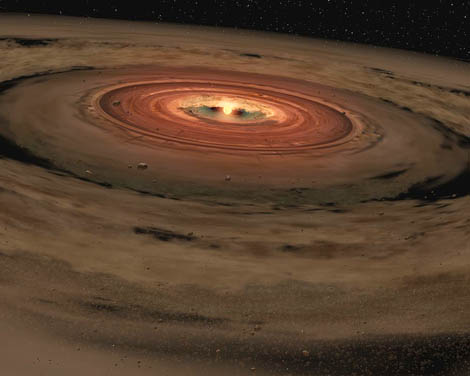 An international team led by astronomer from the Astrophysics Center of the University of Porto (CAUP) Vardan Zh. Adibekyan suggests that metals such as magnesium play an important role in the formation of low-mass planets.
An international team led by astronomer from the Astrophysics Center of the University of Porto (CAUP) Vardan Zh. Adibekyan suggests that metals such as magnesium play an important role in the formation of low-mass planets.
The team analyzed high-resolution spectra of 1111 Sun-like stars obtained by the HARPS (ESO) spectrograph. In 109 of these stars, massive (Jupiter-like) planets are known, and in 26, Neptune-like planets are known.
The investigation focused especially on the study of the abundance of alpha elements in these stars, such as Magnesium (Mg), Silicon (Si) or Titanium (Ti). The results show that the proportion of these elements, in relation to the amount of Iron, is consistently higher in stars with planets, with the largest discrepancy to be observed for Magnesium.
CAUP investigator Vardan Zh. Adibekyan commented that “this discovery indicates that some metals, other than Iron, are involved in the planet formation process, especially when the amount of Iron is smaller than in the case of the Sun. These results strongly restrict theories of planetary formation, especially in the case of low-mass planets”.
The main theory for the formation of planets suggests that they are formed by the "heap" of small particles of heavy elements (metals), giving rise to larger and larger bodies. The results of this study suggest that planets need a minimal amount of these metals to form.
Thus, the formation of planets, even those with a small mass, depends on the type of dust present in the cloud that gave rise to the star and the planetary system.
Author Ricardo Cardoso Reis
Center for Astrophysics of the University of Porto (CAUP)
Science in the Regional Press
Notes:
Alpha Elements are integer multiples of the mass of the nucleus of Helium (He), also known as an alpha particle. As an example, adding an alpha particle (He nucleus) to a Carbon atom results in an Oxygen atom, and adding an alpha particle to it results in a Neon atom.
The article Overabundance of alpha-elements in exoplanet-hosting was published in the magazine Astronomy & Astrophysics (DOI: 10.1051/0004-6361/201219564). The team is composed of Vardan Zh. adibekyan, Nuno Cardoso Santos, Sérgio Sousa, Israeli Garik, Elisa Delgado Mena, Jonay González Hernández, Michel Mayor, Christophe Lovis, Stephan Udry.


















Comments